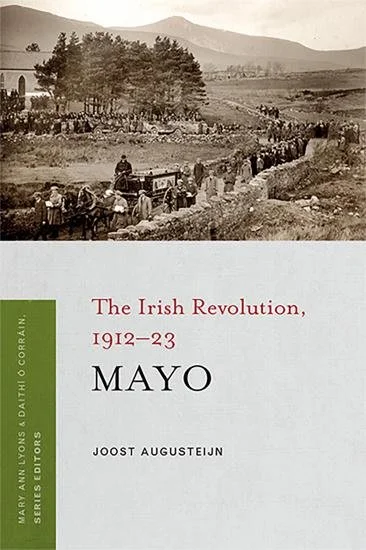A lop-sided study of the Mayo Revolution
Review of Joost Augusteijn’s, Mayo: The Irish Revolution, 1912–23 (Dublin: Four Courts Press, 2023)
(Originally appeared in History Ireland, Nov-Dec 2023).
This is the thirteenth book in the county studies series, drawing on new archival records and scholarship to examine the local Irish revolutionary period. Joost Augusteijn expands his previous PhD research and 1998 study of IRA volunteers in west Mayo, with additional material from north and east of the county.[1] He draws on a rich vein of sources including IRA witness statements, local newspapers and interviews with Volunteers and their families, to present a concise and accessible narrative of local events and personalities in Mayo, over 1912-23.
While outlining the land question’s formative influence on Mayo politics, the Leiden University professor focuses on how prominent nationalist figures shaped the county’s political landscape. Alongside a post-1916 evaluation of more marginal groups such as women, unionists and labour activists, he examines how Sinn Féin eclipsed the once-powerful Irish Party, with a group of radicalized local republicans robustly challenging the British establishment while garnering increased support within their communities. Interesting asides include little-known attempts to land arms from German U-boats off Erris, the low impact of Spanish Flu in Mayo and a surprising post-1918 increase of rape cases in police reports.
Augusteijn outlines an early constitutional-radical political division running east-west in the county, with militant republicanism hugging the poor land around Westport, Castlebar, Balla and Ballinrobe. Yet, while demonstrating that Revolutionary Mayo was exceptionally poor, overwhelmingly agricultural with the highest concentration of small farmers in Ireland, he downplays the role of land hunger in subsequent revolutionary developments. Augusteijn sees the Great War agricultural boom tempering both land agitation and army enlistment, by farmers more concerned with their farms than admonishments from bishops or politicians. He argues that the 70 per cent of Mayo tenant farmers becoming mollified landowners by 1914, contributed to a united concern for the political (rather than the land) question, thereby explaining the enduring and unusual strength of Mayo republicans, unlike in neighbouring counties. He thus claims that support for Sinn Féin was almost universal in Mayo during the War of Independence, boosted by the galvanising of a united front of nationalist protest in 1918 against government threats of conscription, effectively dooming Home Rule and energising republicans. Unfortunately, he does not expand on the growing tension between ITGWU protests and Sinn Féin, or the ‘illegal practices’ within the party’s political successes during the June 1920 local elections.
Augusteijn crafts a clear military and socio-political narrative over the local War of Independence but is less comfortable outside of his familiar west Mayo.[2] He claims that all Mayo Active Service Unit activities ended in mid-June but is unaware of two Flying Columns operating either side of the river Moy and does not mention the Crown Force ambush of ASU no. 1 on 26 June 1921, with the killing of Volunteer Tom Nealon near Ballycastle. North Mayo ASU no. 2 also continued its activities to 1 July with an attack on Culleens RIC station, which saw two policemen executed. For the post-Truce period, he provides a thematic analysis rather than a coherent timeline of the gradual exertion of Free State authority over the county. However, his account of the bloody confrontation between the Free State army and anti-Treaty forces following the republican capture of Ballina on 12 September 1922 is unsatisfactory, not doing justice to the events which saw the deaths of eight Free State soldiers.
Augusteijn concludes that agrarian agitation in Mayo was relatively restrained for a western county, mainly effected by a politically homogenous local constituency, with Sinn Féin replacing the Irish Party and later becoming the anti-Treaty republicans, in virtual control of the county and enjoying large-scale support. While admitting the lack of fundamental change in the lives of most ordinary Mayo people, Augusteijn claims the period as a political revolution, where the dominant nationalist establishment was usurped by republicans, who later carved up the political landscape between small farmer-supporting Fianna Fáil against the larger farmer / business interests of Cumann na nGaedhael. As an addendum, he claims the Irish Revolution also caused a local resurgence of Irish culture in schools, local politics and GAA sports.
Notwithstanding these unevidenced and debatable conclusions, this is a welcome study, considering it was 2012 when Dominic Price published his book on the revolutionary years in Mayo.[3] While a more comprehensive and reflective examination, Augusteijn underplays the importance of land hunger at the centre of the Mayo revolutionary experience and his unfamiliarity with North Mayo results in this self-contained region (larger than county Derry) not being well represented.[4] That said, Joost Augusteijn has drawn together a well-composed, textured narrative providing an important, broad understanding of the years leading up to and past the War of Independence and Civil War in county Mayo.
Author: Dr Liam Alex Heffron
Endnotes
[1] Joost Augusteijn, From Public Defiance to Guerrilla Warfare; The Experience of Ordinary Volunteers in the Irish War of Independence, 1916-1921 (Dublin, 1998).
[2] His claim that Ballina Herald records do not survive from this period is odd, as Castlebar library holds an almost complete set of microfilm copies over 1913-24.
[3] Dominic Price, The Flame and the Candle: War in Mayo 1919-1924 (Cork, 2012).
[4] ‘Irish Townlands’, Mapping for Good in Irish OpenStreetMap community, 2022, n. When calculated, North Mayo comprises 2176 sq. km. This makes the region larger than county Derry — the fifteenth largest county in Ireland at 2118 sq. km. (https://www.townlands.ie/) (5 Sept. 2023).
